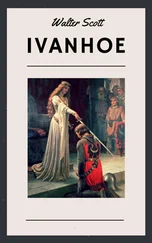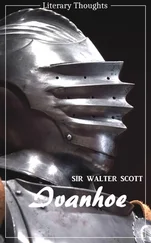line 6. flanking walls, walls protecting it on the sides. Cp. the use of flanked in Dryden’s ‘Annus Mirabilis’ xxvi;-
‘By the rich scent we found our perfumed prey,
Which, flanked with rocks, did close in covert lie.’
Stanza II. line 14. St. George’s banner. St. George’s red cross on a white field was the emblem on the English national standard. Saint George is the legendary patron saint who slew the dragon.
Stanza III. line 29. Horncliff-hillis one of the numerous hillocks to the east of Norham. There is a village of the same name.
A plump of spears. Scott writes, ‘This word applies to flight of water-fowl; but is applied by analogy to a body of horse:-
“There is a knight of the North Country,
Which leads a lusty plump of spears.”
Flodden Field’
line 33. mettled, same as metalled (mettle being a variant of metall, spirited, ardent. So ‘mettled hound’ in ‘Jock o’ Hazeldean.’ Cp. Julius Caesar, iv. 2. 23:-
‘But hollow men, like horses hot at hand,
Make gallant show and promise of their mettle .’
‘Metal’ in the same sense is frequent in Shakespeare. See Meas. for Meas. i. I; Julius Caesar, i. 2; Hamlet, iii 2.
line 35. palisade(Fr. paliser , to enclose with pales), a firm row of stakes presenting a sharp point to an advancing party.
line 38. hasted, Elizabethanism = hastened. Cp. Merch. of Venice, ii. 2. 104-‘Let it be so hasted that supper be ready at the farthest by five of the clock.’
line 42. sewer, taster; squire, knight’s attendant; seneschal, steward. See ‘Lay of the Last Minstrel,’ vi. 6, and note on Par. Lost, ix. 38, in Clarendon Press Milton:-
‘Then marshalled feast
Served up in hall with sewers, and seneschals.’
Stanza IV. line 43. Malvoisie= Malmsey, from Malvasia, now Napoli di Malvasia, in the Morea.
line 55. portcullis, a strong timber framework within the gateway of a castle, let down in grooves and having iron spikes at the bottom.
Stanzas V and VI. Marmion, strenuous in arms and prudent in counsel, has a kinship in spirit and achievement with the Homeric heroes. Compare him also with the typical knight in Chaucer’s Prologue and the Red Cross Knight at the opening of the ‘Faerie Queene.’ Scott annotates ‘Milan steel’ and the legend thus:-
‘The artists of Milan were famous in the middle ages for their skill in armoury, as appears from the following passage, in which Froissart gives an account of the preparations made by Henry, Earl of Hereford, afterwards Henry IV, and Thomas, Duke of Norfolk, Earl Marischal, for their proposed combat in the lists at Coventry:-”These two lords made ample provisions of all things necessary for the combat; and the Earl of Derby sent off messengers to Lombardy, to have armour from Sir Galeas, Duke of Milan. The Duke complied with joy, and gave the knight, called Sir Francis, who had brought the message, the choice of all his armour for the Earl of Derby. When he had selected what he wished for in plated and mail armour, the Lord of Milan, out of his abundant love for the Earl, ordered four of the best armourers in Milan to accompany the knight to England, that the Earl of Derby might be more completely armed.”-JOHNES’ Froissart , vol. iv. p.597.
‘The crest and motto of Marmion are borrowed from the following story:-
Sir David de Lindsay, first Earl of Cranford, was, among other gentlemen of quality, attended, during a visit to London in 1390, by Sir William Dalzell, who was, according to my authority, Bower, not only excelling in wisdom, but also of a lively wit. Chancing to be at the Court, he there saw Sir Piers Conrtenay, an English knight, famous for skill in tilting, and for the beauty of his person, parading the palace, arrayed in a new mantle, bearing for device an embroidered falcon, with this rhyme,-
“I bear a falcon, fairest of night,
Whoso pinches at her, his death is dight1
In graith2.”
――――――――――――――――――――――――――-
1prepared. 2armour.
――――――――――――――――――――――――――-
‘The Scottish knight, being a wag, appeared next day in a dress exactly similar to that of Courtenay, but bearing a magpie instead of the falcon, with a motto ingeniously contrived to rhyme to the vaunting inscription of Sir Piers:-
“I bear a pie picking at a piece,
Whoso picks at her, I shall pick at his nese3,
In faith.”
――――――――――――――――――――――――――-
3nose
――――――――――――――――――――――――――-
‘This affront could only be expiated by a just with sharp lances. In the course, Dalzell left his helmet unlaced, so that it gave way at the touch of his antagonist’s lance, and he thus avoided the shock of the encounter. This happened twice:-in the third encounter, the handsome Courtenay lost two of his front teeth. As the Englishman complained bitterly of Dalzell’s fraud in not fastening his helmet, the Scottishman agreed to run six courses more, each champion staking in the hand of the King two hundred pounds, to be forfeited, if, on entering the lists, any unequal advantage should be detected. This being agreed to, the wily Scot demanded that Sir Piers, in addition to the loss of his teeth, should consent to the extinction of one of his eyes, he himself having lost an eye in the fight of Otterburn. As Courtenay demurred to this equalisation of optical powers, Dalzell demanded the forfeit; which, after much altercation, the King appointed to be paid to him, saying, he surpassed the English both in wit and valour. This must appear to the reader a singular specimen of the humour of that time. I suspect the Jockey Club would have given a different decision from Henry IV.’
lines 85-6. ‘The arms of Marmion would be Vairee, a fesse gules-a simple bearing, testifying to the antiquity of the race. The badge was An ape passant argent, ringed and chained with gold. The Marmions were the hereditary champions of England. The office passed to the Dymokes, through marriage, in the reign of Edward III.’-’Notes and Queries,’ 7th S. III. 37.
Stanza VII. line 95. ‘The principal distinction between the independent esquire (terming him such who was attached to no knight’s service) and the knight was the spurs, which the esquire might wear of silver, but by no means gilded.’-Scott’s ‘Essay on Chivalry,’ p.64.
With the squire’s ‘courteous precepts’ compare those of Chaucer’s squire in the Prologue,-
‘He cowde songes make and wel endite,
Juste and eek daunce, and wel purtreye and write.
. . .
Curteys he was, lowely, and servysable,
And carf byforn his fader at the table.’
Stanza VIII. line 108. Him listedis an Early English form. Cp. Chaucer’s Prologue, 583,-
‘Or lyve as scarsly as hym list desire.’
In Elizabethan English, which retains many impersonal forms, list is mainly used as a personal verb, as in Much Ado, iii. 4,-
‘I am not such a fool to think what I list ,’
and in John iii. 8, ‘The wind bloweth where it listeth.’ Even then, however, it was sometimes used impersonally, as in Surrey’s translation of AEneid ii. 1064,-
Читать дальше






